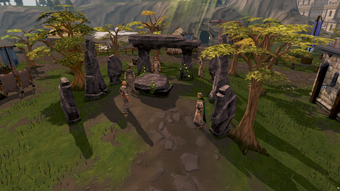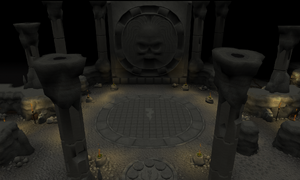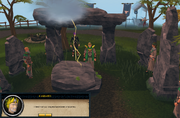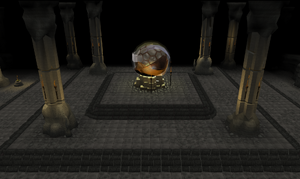(Updated. New Druidic Ritual concerns trolls, but this makes more sense.) |
(→Varrock Stone Circle: This Image is no longer needed, as the quest was remade... and giving new information.) |
||
| Line 41: | Line 41: | ||
=== Varrock Stone Circle === |
=== Varrock Stone Circle === |
||
| − | [[File: |
+ | [[File:Varrock circle.png|thumb|300px|The stone circle of Varrock, now taken over by a Zamorakian cult.]] |
| − | The Stone Circle south of [[Varrock]] fell out of Guthixian hands in the year 19 of the Fifth Age, |
+ | The Stone Circle south of [[Varrock]] fell out of Guthixian hands in the year 19 of the Fifth Age, seemly to be under [[Zemouregal]] Order and possession with the help of [[Dark Wizards]]. |
| − | |||
| − | Delrith was slain almost immediately after being summoned, by the famous Varrockian hero [[Wally]]. Despite this victory, the Circle has remained in the control of Zamorakian wizards ever since. In the year 169, during the [[Demon Slayer]] quest, players foil Delrith's second appearance, forcing Denath to flee to the [[Kharidian Desert]] with a new group of followers, yet today the Circle still remains under Zamorakian control. |
||
The druids are currently attempting to regain their hold on the Varrock Stone Circle. During [[Druidic Ritual]], a potion is made using the [[Cauldron of Thunder]] that will reinforce Guthixian power in the Varrock circle, but the results are yet to be seen. |
The druids are currently attempting to regain their hold on the Varrock Stone Circle. During [[Druidic Ritual]], a potion is made using the [[Cauldron of Thunder]] that will reinforce Guthixian power in the Varrock circle, but the results are yet to be seen. |
||
| + | |||
| + | The Stone was also used as an Alarm when [[Guthix's Cave]] was found. |
||
=== Ancient Guthixian Temple Circle === |
=== Ancient Guthixian Temple Circle === |
||
Revision as of 05:20, 6 June 2013
Stone circles are holy sites of Guthixian religion scattered across the world of Gielinor. Stone circles are named such for their appearance, which is similar to that of the real-world Stonehenge.

During the Years 1 to 200 of the Fourth Age, Guthixian thought and devotion spread more openly. During this time, dozens of holy circles dedicated to Guthix were constructed by druids, an order which had silently endured the God Wars for more than 4,000 years. Although this period truly popularised the stone circle, its origins are considerably older, dating back to the late First or early Second Age. The stones of the circle are said to represent each of the Guardians of Guthix.
Despite their importance to Guthixian religion, today all but five stone circles have been completely destroyed.
- The only stone circle still under active Guthixan control is in Taverley.
- Another under Zamorakian control exists south of Varrock.
- Another Zamorakian circle/altar is found in Taverley Dungeon.
- The fourth is found miles beneath southern Misthalin, in the remains of the first Guthixian Temple.
- A fifth one consists only of the outer circle and surrounds the Avatar of Creation at Soul Wars, although it is possible this is an artificial stone circle, not created by the followers of Guthix.
History
Origins and design

Guthix creates runes using the Stone.
In the First Age, the god Guthix found the world now known as Gielinor, as seen in Meeting History. Although details regarding this time are few, it is believed that Guthix took the place of the Elder Gods as master of the world and, using his powers and the Stone of Jas, shaped the world for 4,000 years. Creating many races and bringing many others from other worlds, Guthix gained a powerful following that consisted of nearly every race to walk Gielinor. After 4,000 years, Guthix went into a state of deep hibernation and left the world to its own devices. As he slept, his following was diluted with that of other newly-arrived gods, many of whom possessed violent intent.

The most ancient place of worship of Guthix.
Although there are no definitive records from these ages that speak of Stone Circles, the Circles' design suggests their origins date back to the First or Second Age. Until recently, this date was largely scholarly speculation, but new archaeological finds have proven the theory. The first Stone Circle was erected miles beneath the surface of what is now southern Misthalin, in what is now usually referred to simple as the Ancient Guthix Temple. It was here that, shortly before or after Guthix's departure from Gielinor, the High Order of Guthix constructed the first Stone Circle. The Circle is actually part of a complex locking mechanism used to protect the Stone of Jas.
The next Circles were likely erected by Guthix's most devout followers, the druids and wizards of the time. As many prominent Second Age Menaphite scholars of cities such as Uzer and Ullek professed, the sphere and thus, the circle, were widely considered the most aesthetically pleasing shapes of the time. The Stone Circles' distinctive spherical shape and basic design speak of ancient origins, while at the same time reflecting Guthixian balance ideologies and drawing from the High Order of Guthix's original Circle. There is evidence that the Circles were infused with some holy directable energy, although its nature is largely unknown. The popularity of the Stone Circle came to an abrupt end, though, with the dawn of the Third Age.
Destruction
Six thousand years into Gielinor's recorded history, a cataclysmic 4,000-year-war known as the "God Wars" began. Zaros, a mighty deity with a kingdom encompassing much of modern-day Misthalin, Asgarnia, Morytania, and the Wilderness, was betrayed in the final year of the Second Age by his Mahjarrat general Zamorak. Zaros' banishment and Zamorak's ascension to godhood would then ultimately set in motion a chain of events that led to the longest and darkest war in Gielinor's history.
During the God Wars, the mostly peaceful Guthixians were forced to conceal themselves from the constantly warring races and religious factions. Choosing the path of balance and non-intervention, the Guthixians were not well-received by the people of the time, who lived solely by war. Forced into hiding, the Guthixians lost virtually any holy sites, including the Circles, that they had erected during the First and Second Ages, their legacy all but forgotten. To counter the pacifism of the druids with balance, Guthix visited one of his followers in a dream and ordered to found the military order of the Void Knights to fight for balance. After the Wars, they were seemingly disbanded, but returned in the Fifth Age to battle the void pests and Melville Grayzag, a megalomaniac psychopath who used the pests to take over Gielinor in the Fifth Age's second century.
The circles resurface
The stone circle of Varrock, now taken over by a Zamorakian cult.
In roughly the Year 4,000 of the Third Age, Guthix was awakened from his slumber by the sounds of the war, which was finally beginning to threaten the world's very existence. Guthix, more powerful than any of the gods at the time, immediately demanded the war be brought to an end, else he would destroy the world he had created simply to end the war. He further laid down the Edicts of Guthix, a set of laws stating that the gods could no longer walk the mortal realm and that no wars with the potential to begin a second God War could be initiated. This began the Fourth Age.
Guthix's few surviving worshippers resurfaced following the beginning of the Fourth Age, their numbers bolstered by those who had taken the god's reappearance to heart. Even after Guthix left the mortal plane, his ideologies continued to spread. The first 200 years of the Fourth Age saw the construction of many Stone Circles, all small but elaborate. Gielinor, still a place of conflict as races fought for supremacy, proved inhospitable to the Stone Circles, which were not built to withstand attack. By the current day, the Year 169 of the Fifth Age, only four - with a possible fifth - of the Circles survive, and only one of these is still in Guthixian control.
Modern stone circles
Taverley Stone Circle

A ritual is performed to regain control of the Varrock circle.
The Stone Circle found in Taverley is the last surviving Circle still under Guthixian control. The circle is incredibly important to the druidic order of Taverley, it serving as their primary worship site as well as a place of study and research.
The Circle is overseen primarily by Kaqemeex, an important druid within Taverley.
Varrock Stone Circle
The stone circle of Varrock, now taken over by a Zamorakian cult.
The Stone Circle south of Varrock fell out of Guthixian hands in the year 19 of the Fifth Age, seemly to be under Zemouregal Order and possession with the help of Dark Wizards.
The druids are currently attempting to regain their hold on the Varrock Stone Circle. During Druidic Ritual, a potion is made using the Cauldron of Thunder that will reinforce Guthixian power in the Varrock circle, but the results are yet to be seen.
The Stone was also used as an Alarm when Guthix's Cave was found.
Ancient Guthixian Temple Circle
The first Stone Circle was erected by the High Order of Guthix, a collection of druids who followed Guthix in the very early days of Guthix's activity. Constructed in either the late First or early Second Age, the original Stone Circle stands even today, but only recently has been rediscovered.

The Stone of Jas, protected by the first Stone Circle.
The Circle was constructed in a massive subterranean crevice that stretches for miles beneath modern day Misthalin, far beyond what even the first Dorgeshuun cave goblins dared to explore. It was at a shelf in the crevice that a temple to Guthix was created, perhaps with the direct aid of the god himself.
Used as part of a complex locking device, the first Circle was not only a symbol of the Order's loyalty to Guthix, but a way to keep safe the fabled Stone of Jas. It was in this hidden rock temple that Guthix placed the Stone after he fell into his 6,000-year slumber. Its isolation not only allowed the High Order to worship in total solitude, but also kept the Stone from being discovered. The Stone Circle remains hidden beneath the floor of the temple's main chamber, east of a small dolmen.
Only by making 8 specific herbal offerings to their corresponding statues could a member of the Order reveal the Circle. Each offering would grant the druid one miniature set of columns, which, when set upon the appropriate section of the dolmen, would release a lock keeping the larger version of the columns hidden. Once all 8 miniature pieces were placed upon the dolmen, the 8 real columns would rise from the floor of the temple. This section of floor would then rise from the ground and fit the pillars into a massive doorway, behind which the Stone of Jas could be found; albeit protected by a mighty Balance Elemental.
During the dawn of the Fifth Age, it was thought that the Fremennik wanderer V------- discovered the Guthixian Temple and the Stone Circle within, gaining access to the Stone of Jas, effectively discovering runes and creating the Moon Clan. However,it was further said V------- discovered the Stone in the Fremennik area. It was this discovery that led to humanity's dominance in much of Gielinor, although V------- never revealed where he had found the rune essence.
During the course of While Guthix Sleeps, an adventurer finds the temple and manages to solve the Stone Circle lock. However, by doing this, the Mahjarrat Lucien is able to steal the Stone and corrupt the area with numerous Tormented Demons. Miraculously, the Stone Circle here remains intact, although the doorway it protects remains open and its interior desecrated.
Soul Wars Stone Circles
Similar stone circles appear in the Soul Wars activity, most notably surrounding the Avatar of Creation.
Trivia
- Prior to the graphical updates of Varrock and Taverley, the Stone Circles looked much more similar to the real-world Stonehenge. Their appearance has changed significantly since then, although their basic design and minimap appearance remain unchanged.
- The druids in Runescape being related to the Stone Circle is possibly a reference to Ancient Order of Druids.
Template:Featured article
